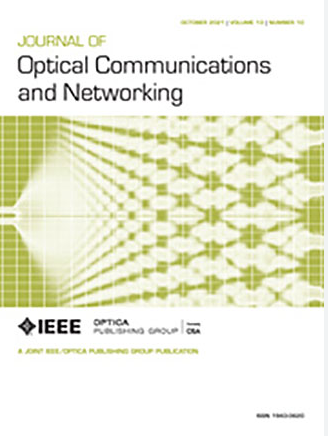光接入网的全软件化[特邀]
IF 4.3
2区 计算机科学
Q1 COMPUTER SCIENCE, HARDWARE & ARCHITECTURE
引用次数: 0
摘要
光接入系统需要满足从传统业务到新业务不断增长的需求。网络功能虚拟化(NFV)在接入系统中的应用为灵活的功能部署和敏捷的服务创建提供了前景,而光线路终端(OLT)的上层功能软件化也在不断发展。为了最大限度地提高灵活性,还在研究底层功能的软件化,包括媒体访问控制(MAC)、物理层(PHY)功能和数字信号处理(DSP)。虽然已经演示了带有软件实时10G-EPON物理编码子层(PCS)的单端口10gb /s系统,但还没有演示具有更高输出速度的系统。本文在通用服务器上构建了一个软件化的四端口10G-EPON pc,包括加扰和前向纠错(FEC),并对其实时吞吐量、延迟和功耗进行了评估。我们利用轮询数据传输和多线程技术构建了一个包含四端口业务节点接口(SNIs)和四端口无源光网络(PON)接口的演示平台。结果表明,与单端口实现相比,我们的平台实现了大约${4}\times {10.3125} {\rm Gb/s}$吞吐量,0.5 ms的往返延迟和每个端口功耗降低66%。本文章由计算机程序翻译,如有差异,请以英文原文为准。
Full softwarization in optical access networks [Invited]
Optical access systems are needed to meet the ever-increasing range of requirements from legacy services to new services. The application of network function virtualization (NFV) to access systems is promising for flexible function deployment and agile service creation, while the softwarization of upper-layer functions has been progressing for the optical line terminal (OLT). To maximize the flexibility, the softwarization of lower-layer functions, including media access control (MAC), physical-layer (PHY) functions, and digital signal processing (DSP), is also being studied. Although one-port 10 Gb/s systems with softwarized real-time 10G-EPON physical coding sublayer (PCS) have already been demonstrated, systems with higher output speeds have not been demonstrated. This paper builds a softwarized four-port 10G-EPON PCS, including scrambling and forward error correction (FEC), on a general-purpose server and evaluates its real-time throughput, latency, and power consumption. We build a demonstration platform with four-port service node interfaces (SNIs) and four-port passive optical network (PON) interfaces using polling-based data transfer and multi-threading. The results show that our platform achieves approximately ${4} \times {10.3125}\;{\rm Gb/s}$ throughput, 0.5 ms round-trip latency, and a 66% reduction in power consumption per port compared to a single-port implementation.
求助全文
通过发布文献求助,成功后即可免费获取论文全文。
去求助
来源期刊
CiteScore
9.40
自引率
16.00%
发文量
104
审稿时长
4 months
期刊介绍:
The scope of the Journal includes advances in the state-of-the-art of optical networking science, technology, and engineering. Both theoretical contributions (including new techniques, concepts, analyses, and economic studies) and practical contributions (including optical networking experiments, prototypes, and new applications) are encouraged. Subareas of interest include the architecture and design of optical networks, optical network survivability and security, software-defined optical networking, elastic optical networks, data and control plane advances, network management related innovation, and optical access networks. Enabling technologies and their applications are suitable topics only if the results are shown to directly impact optical networking beyond simple point-to-point networks.

 求助内容:
求助内容: 应助结果提醒方式:
应助结果提醒方式:


